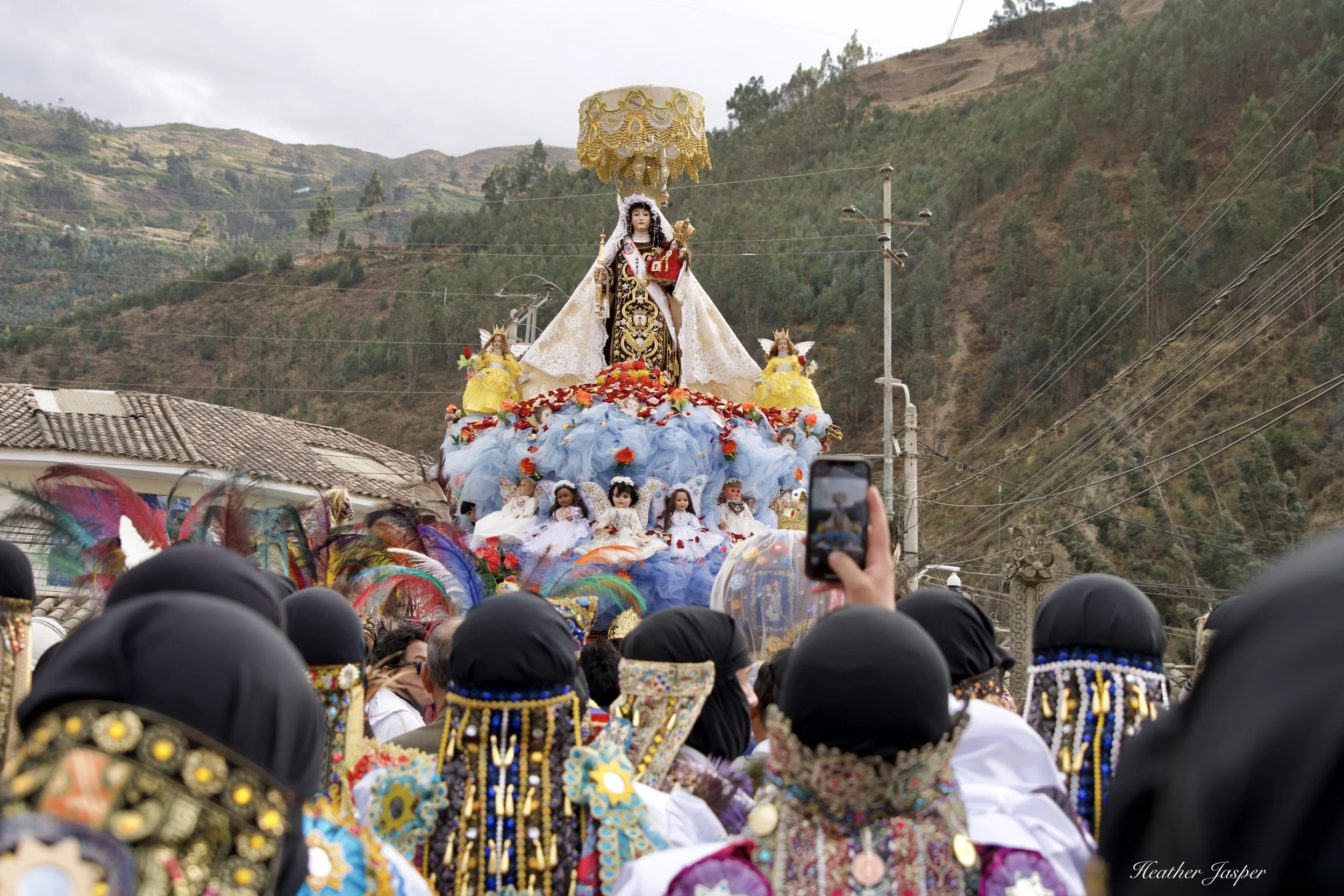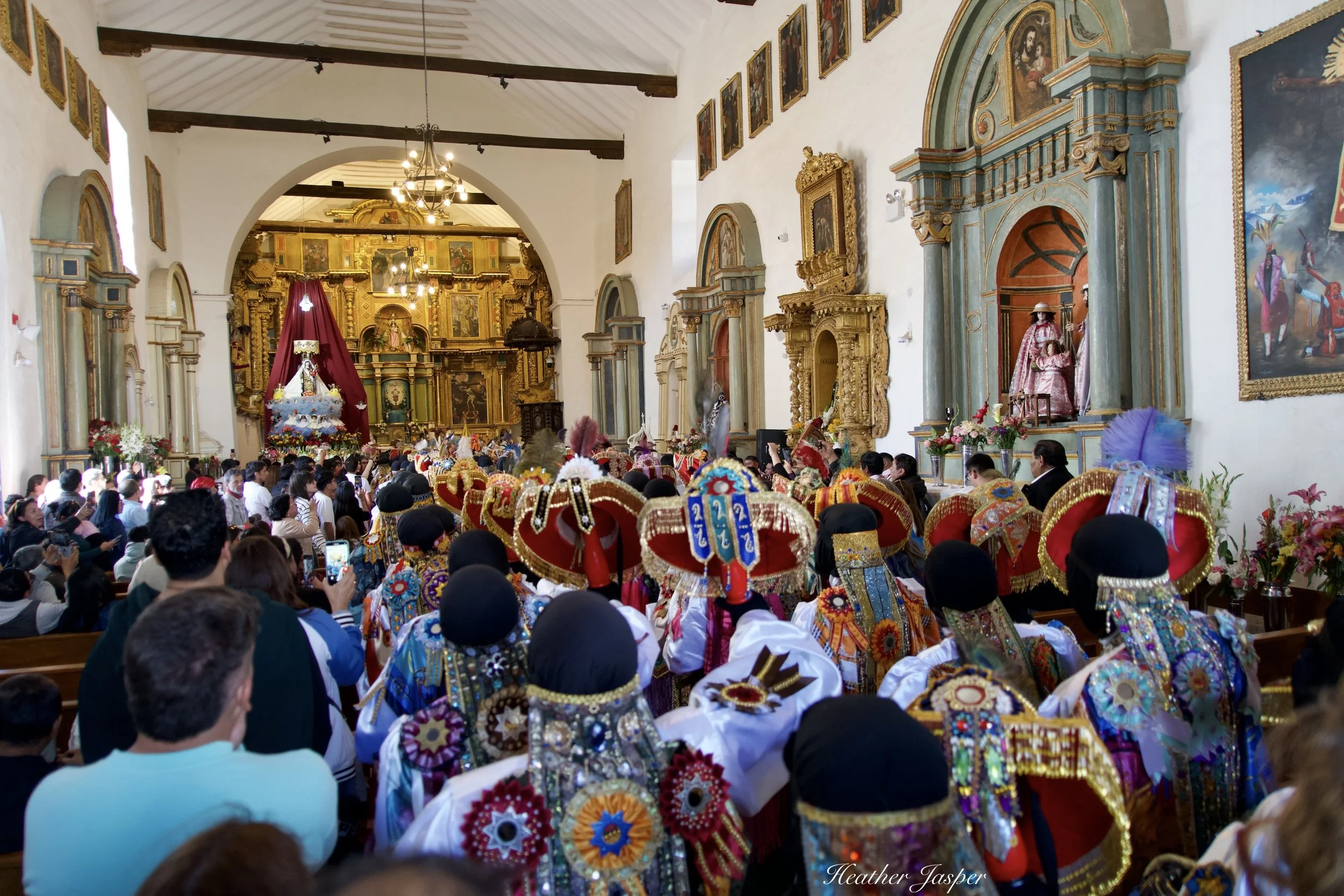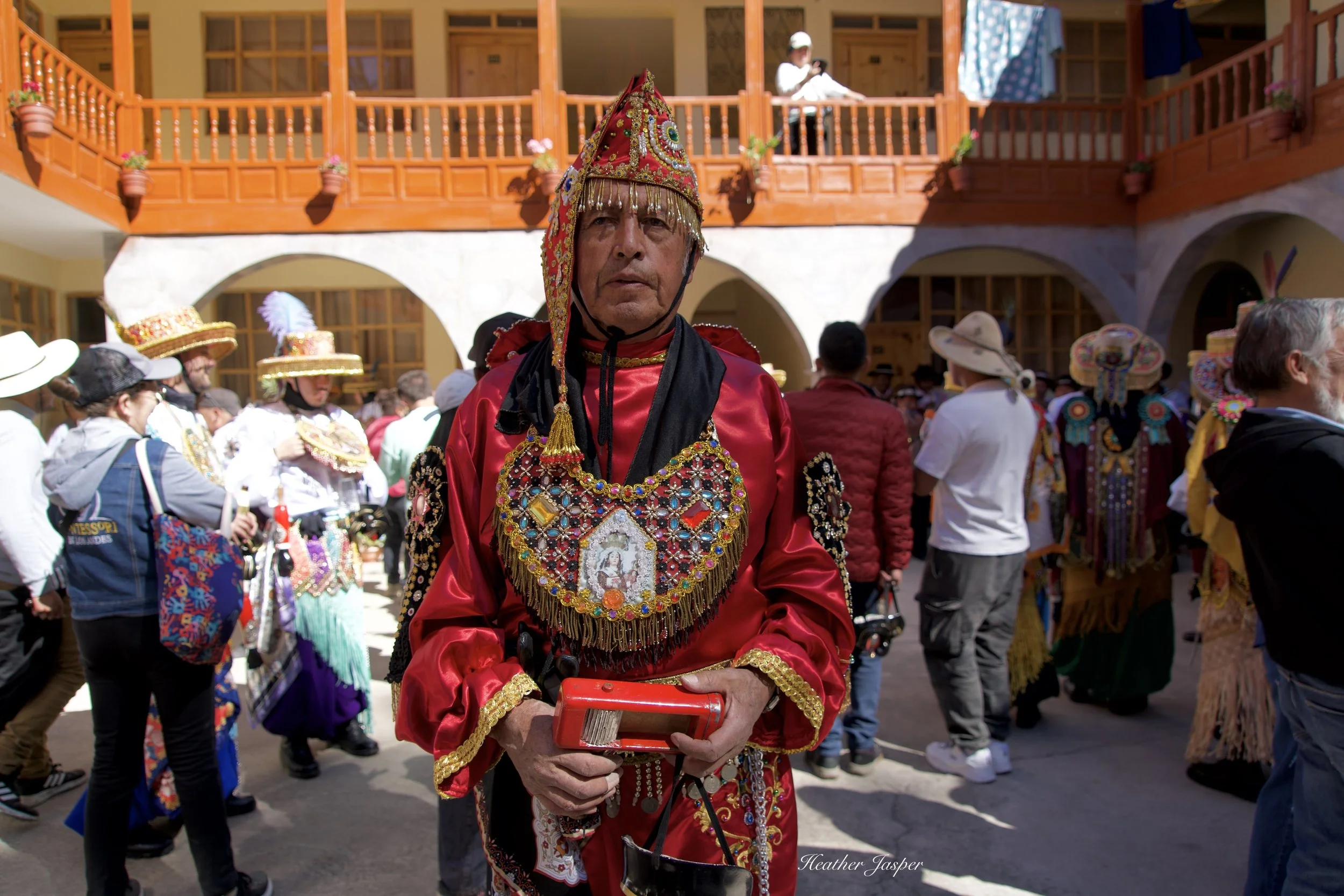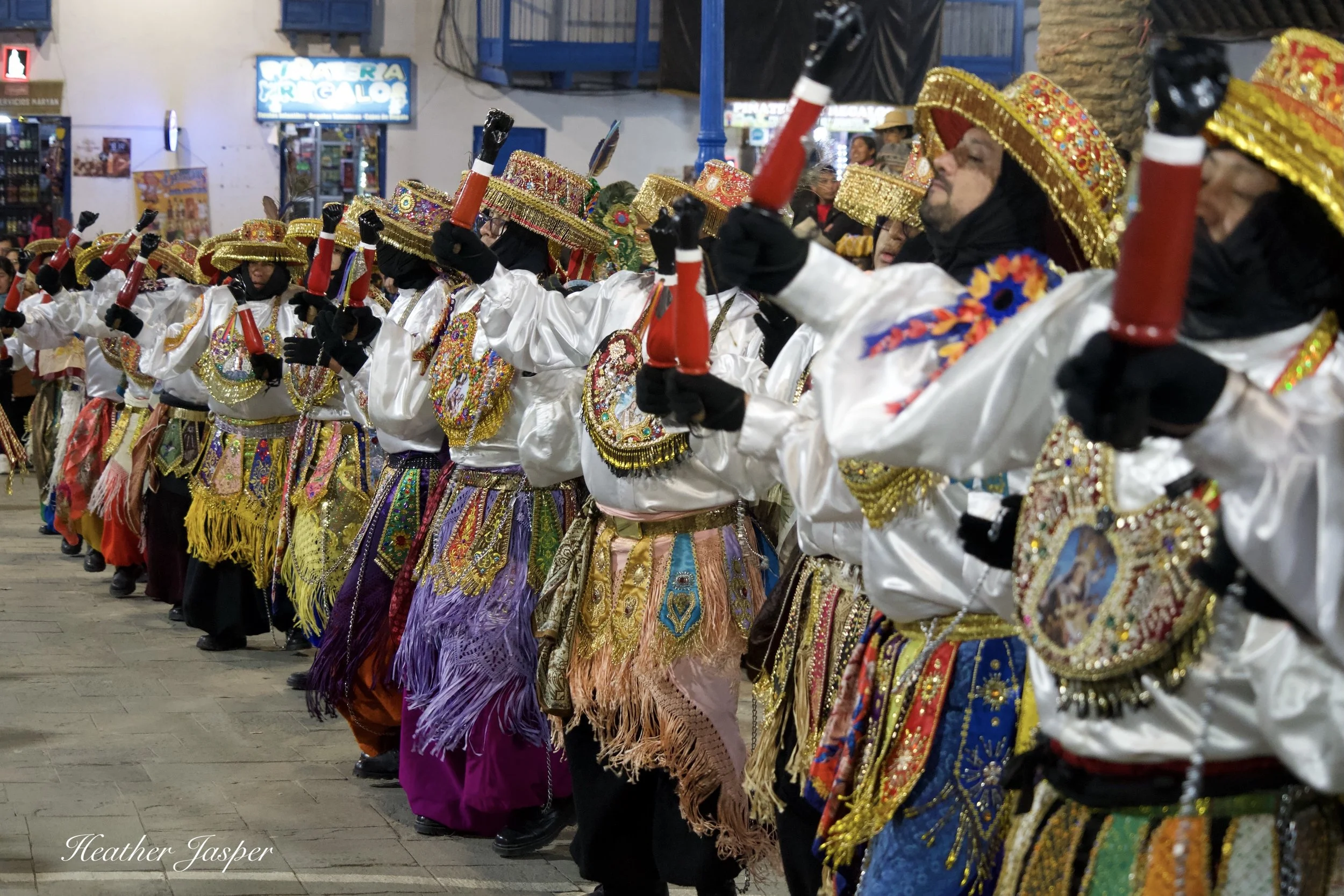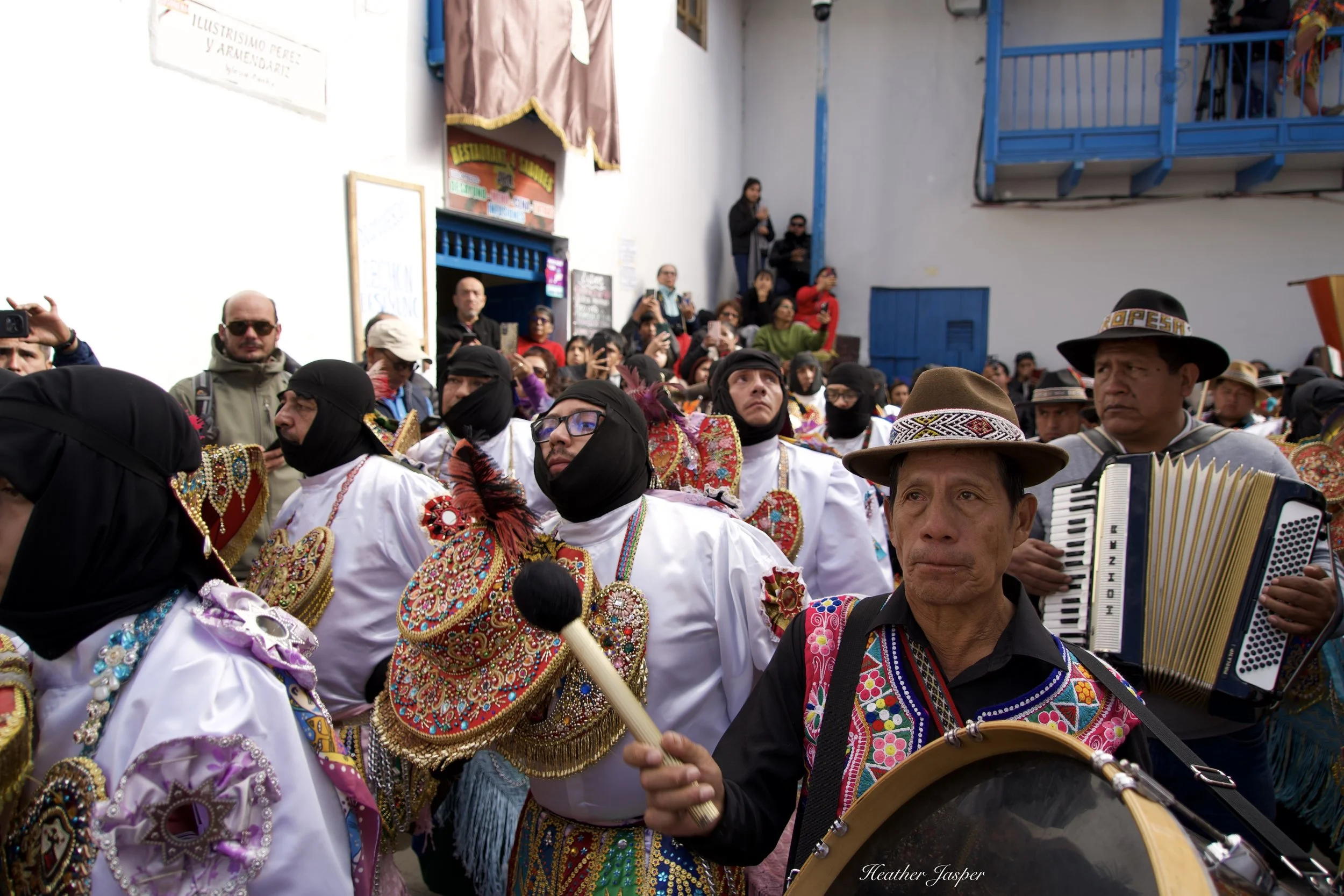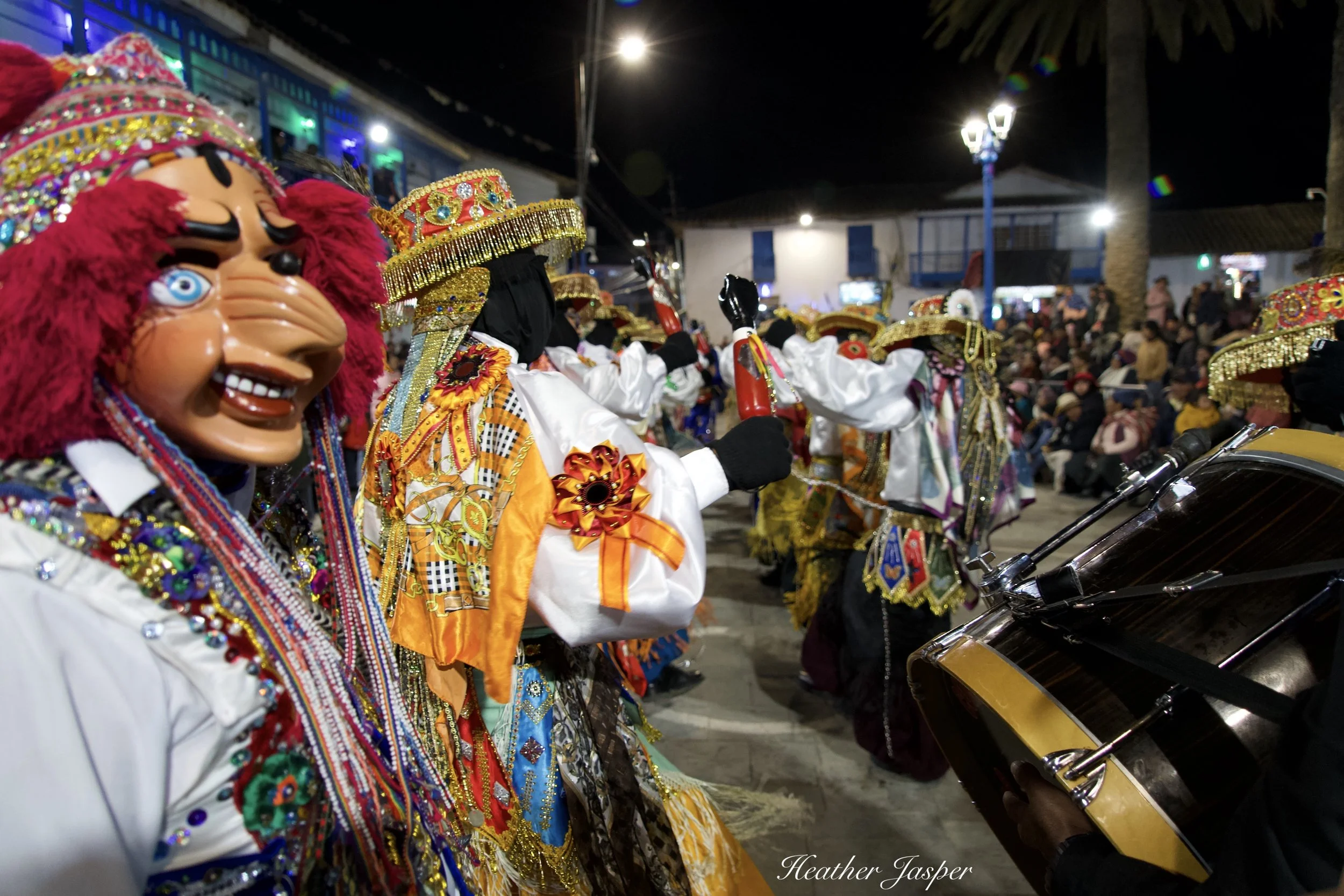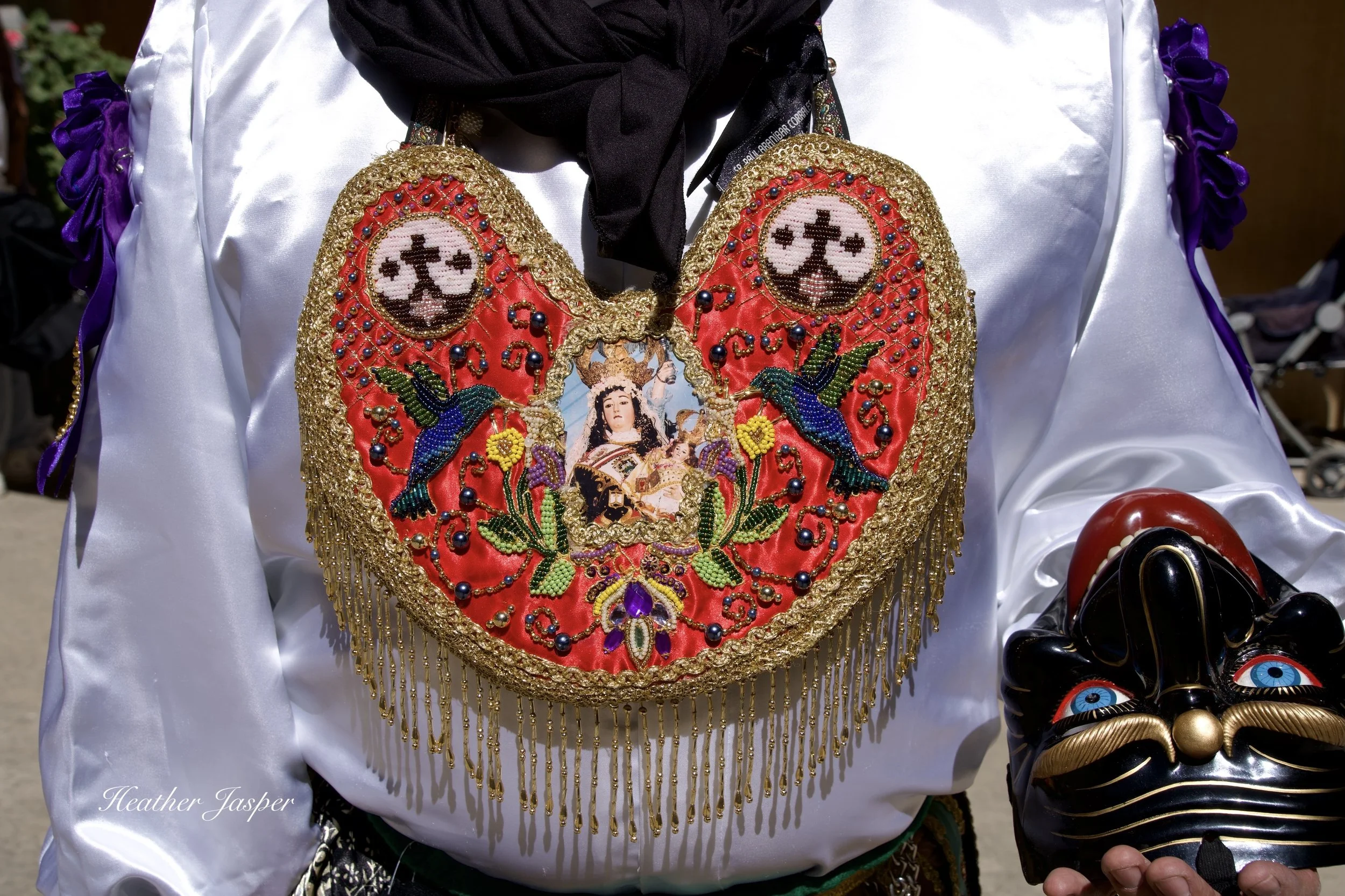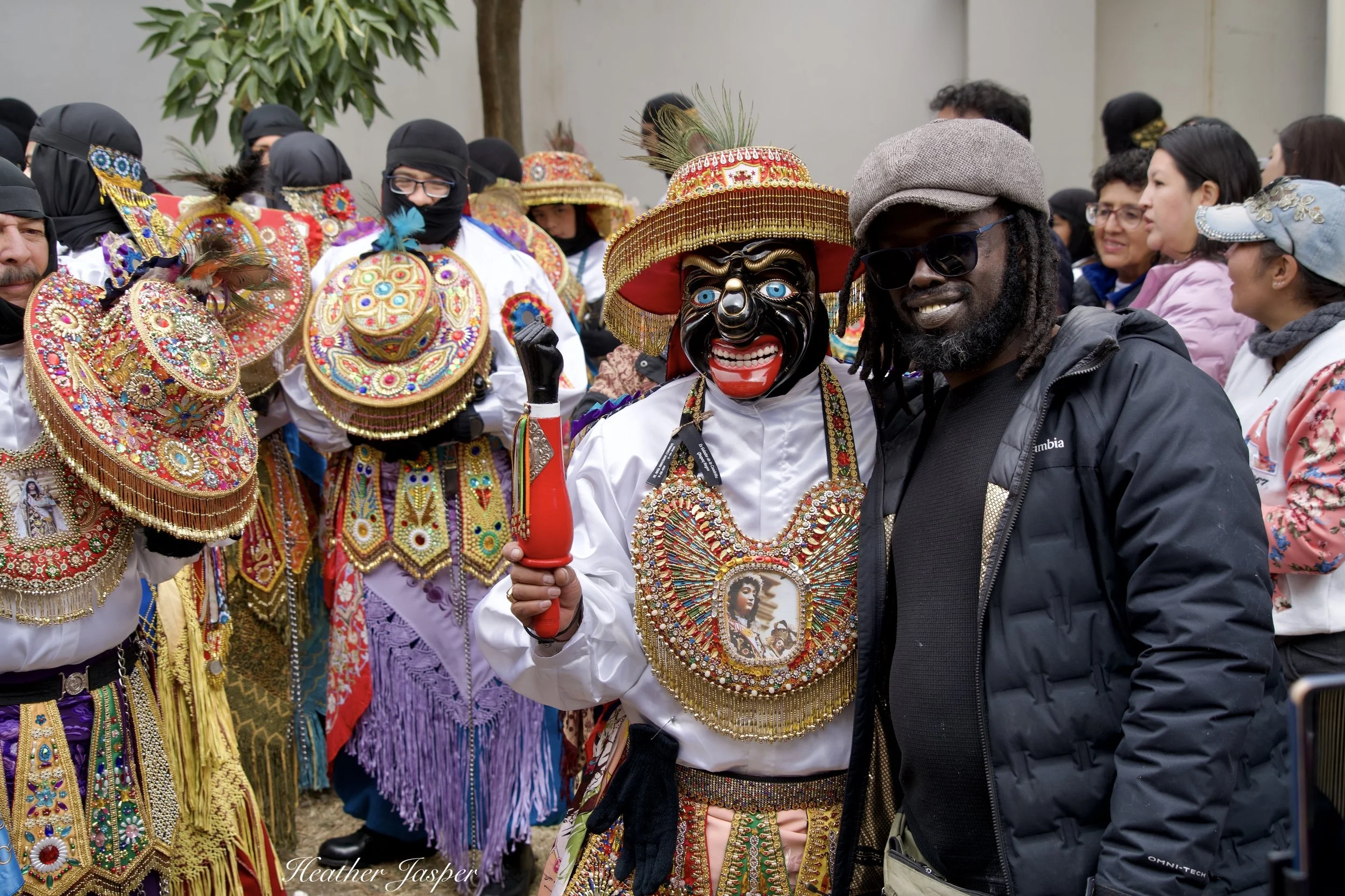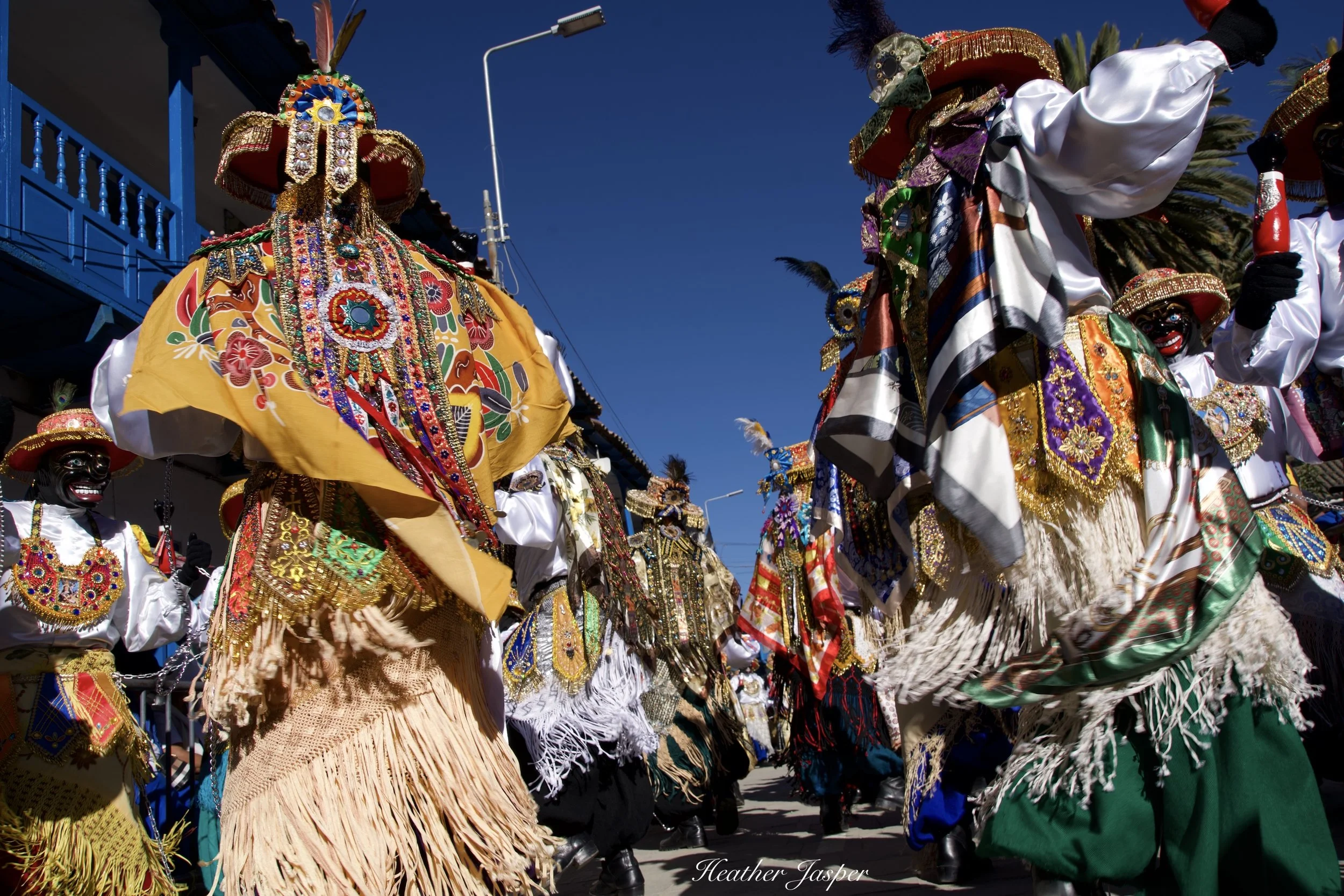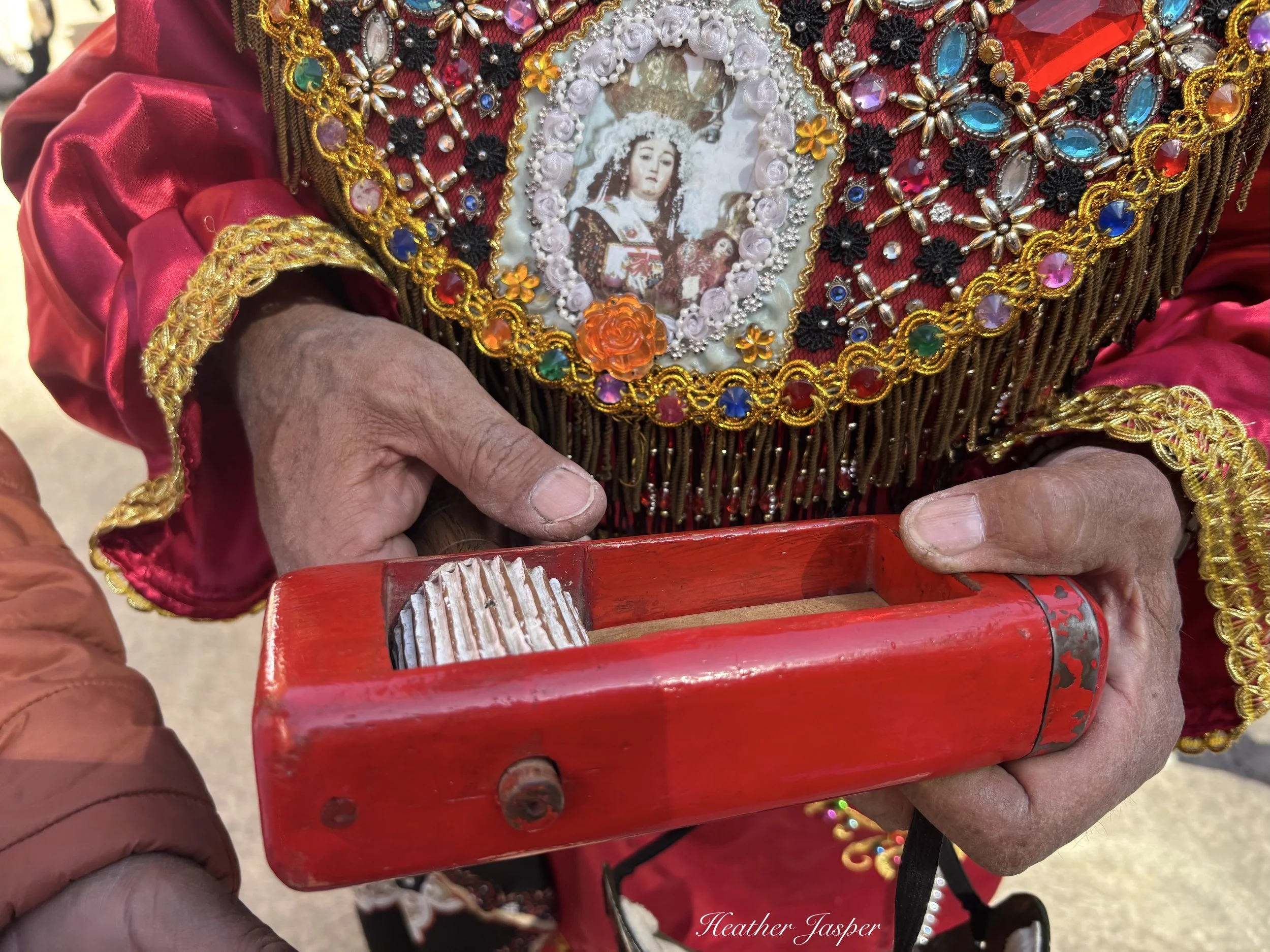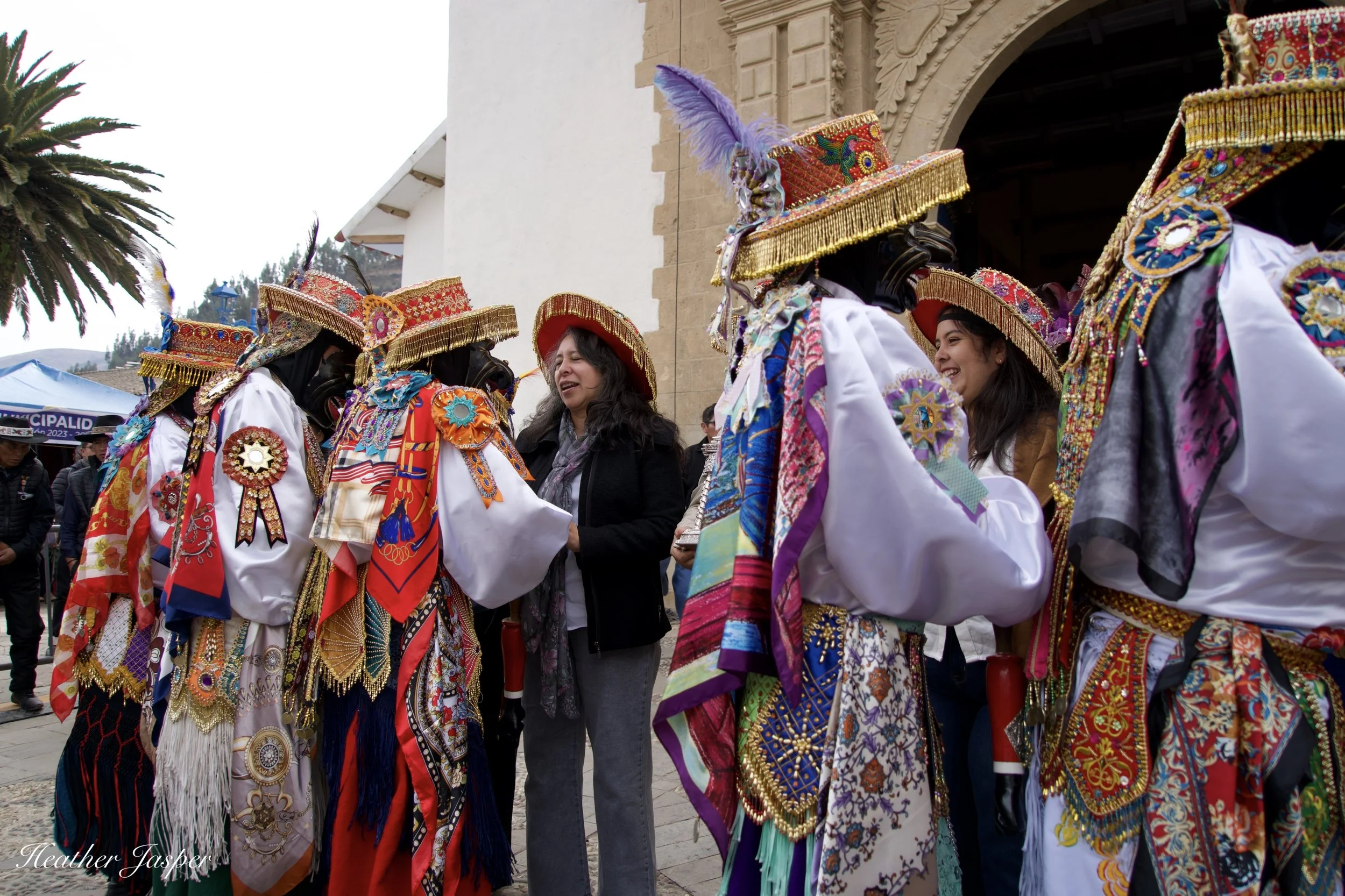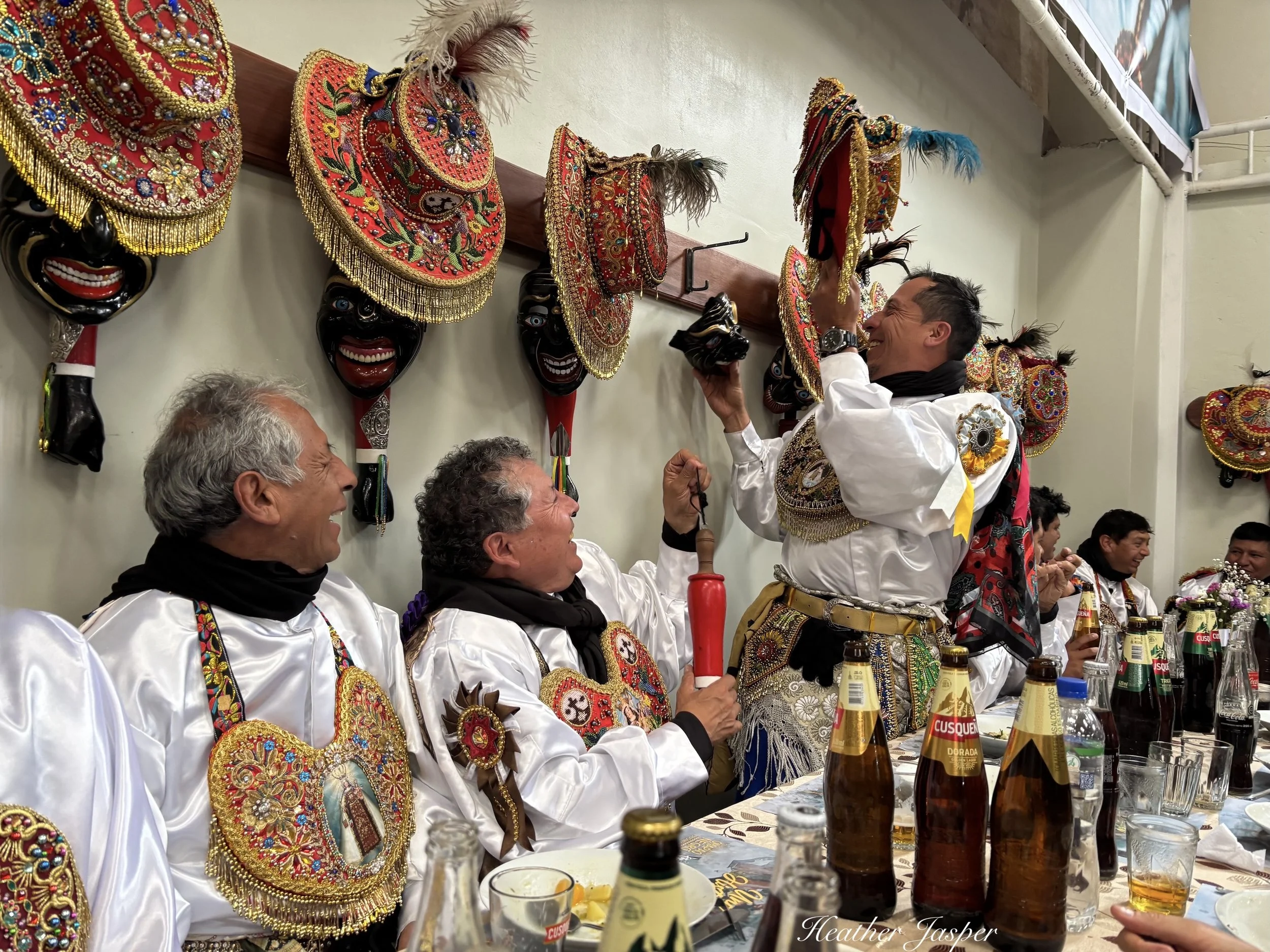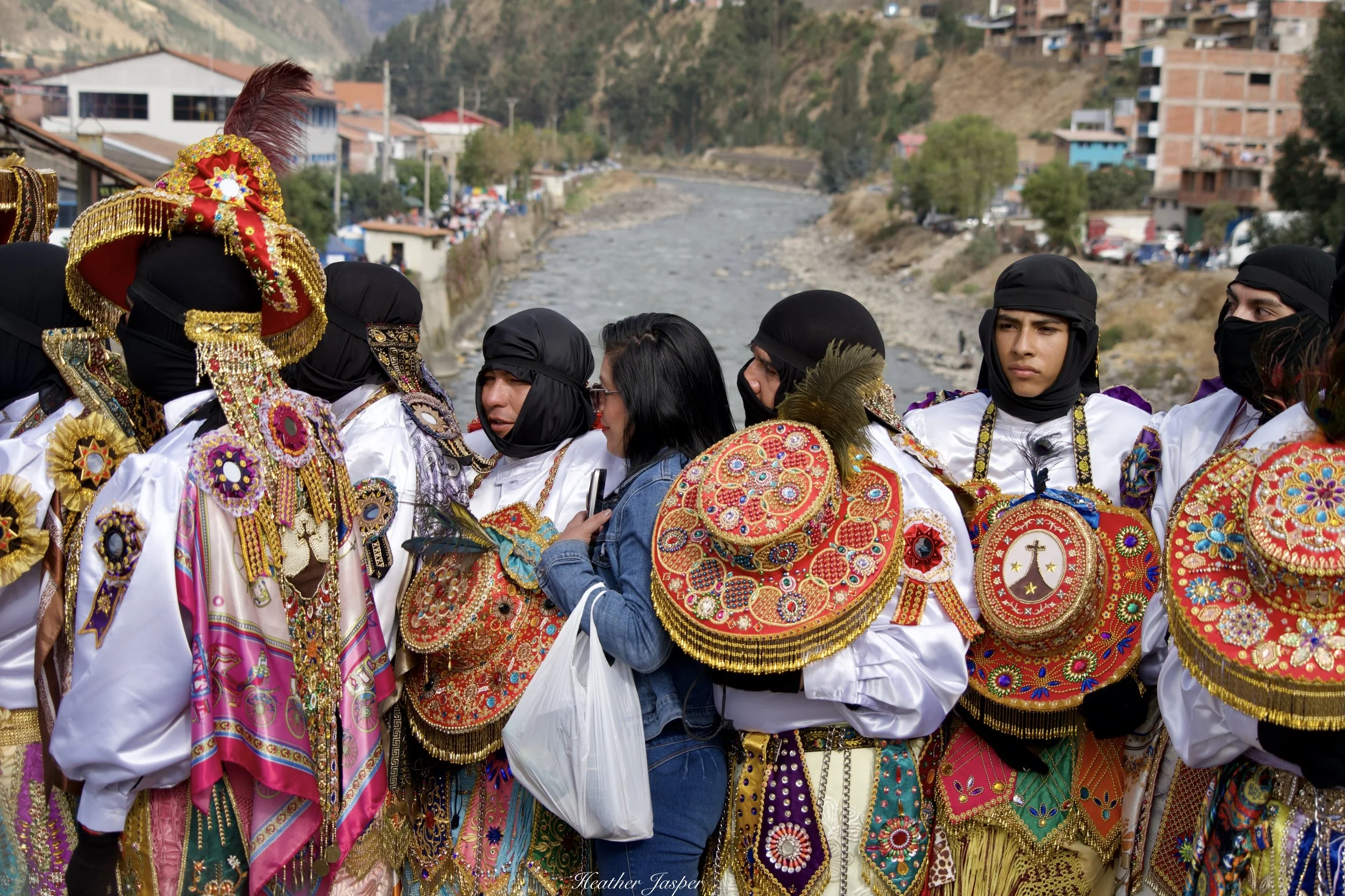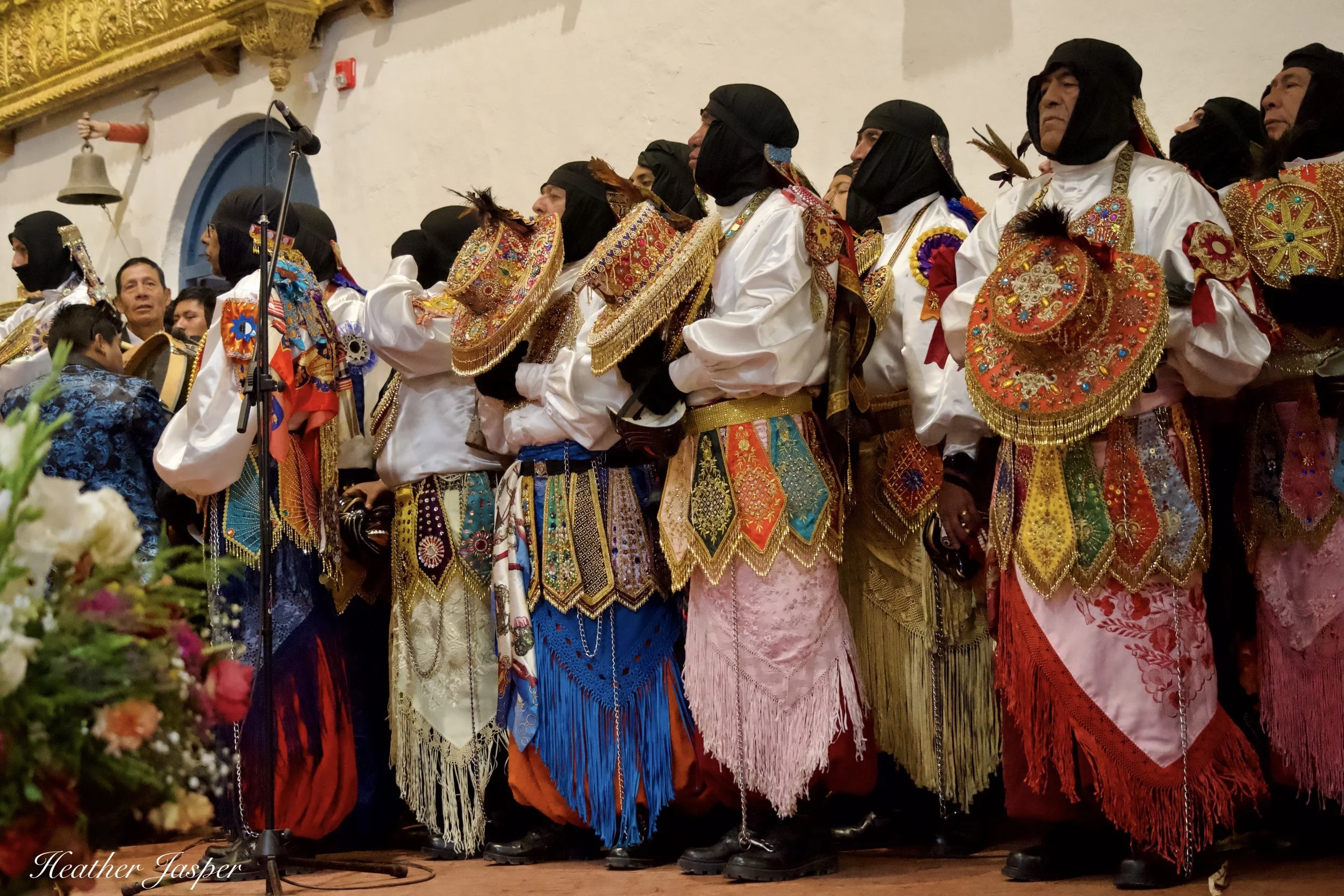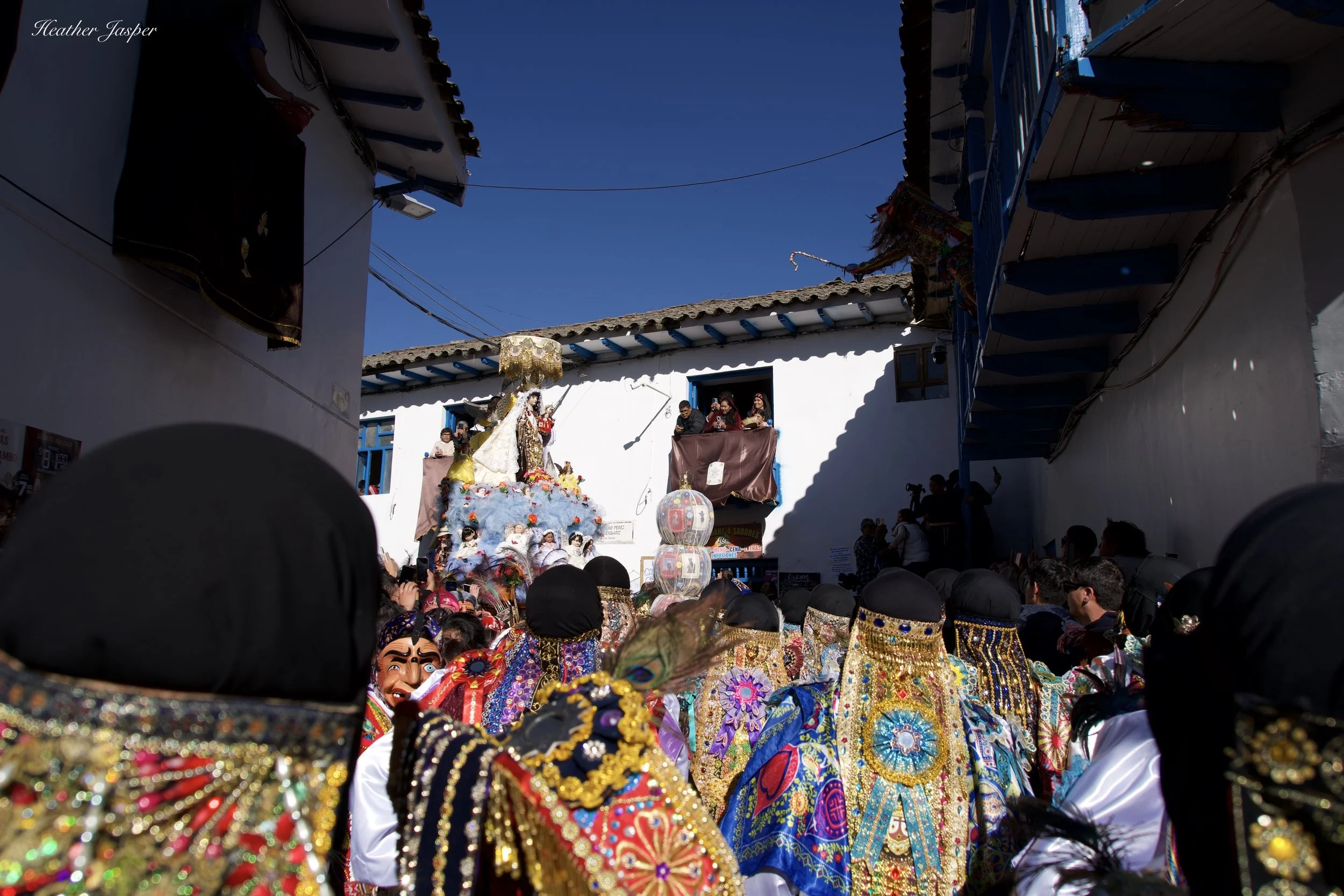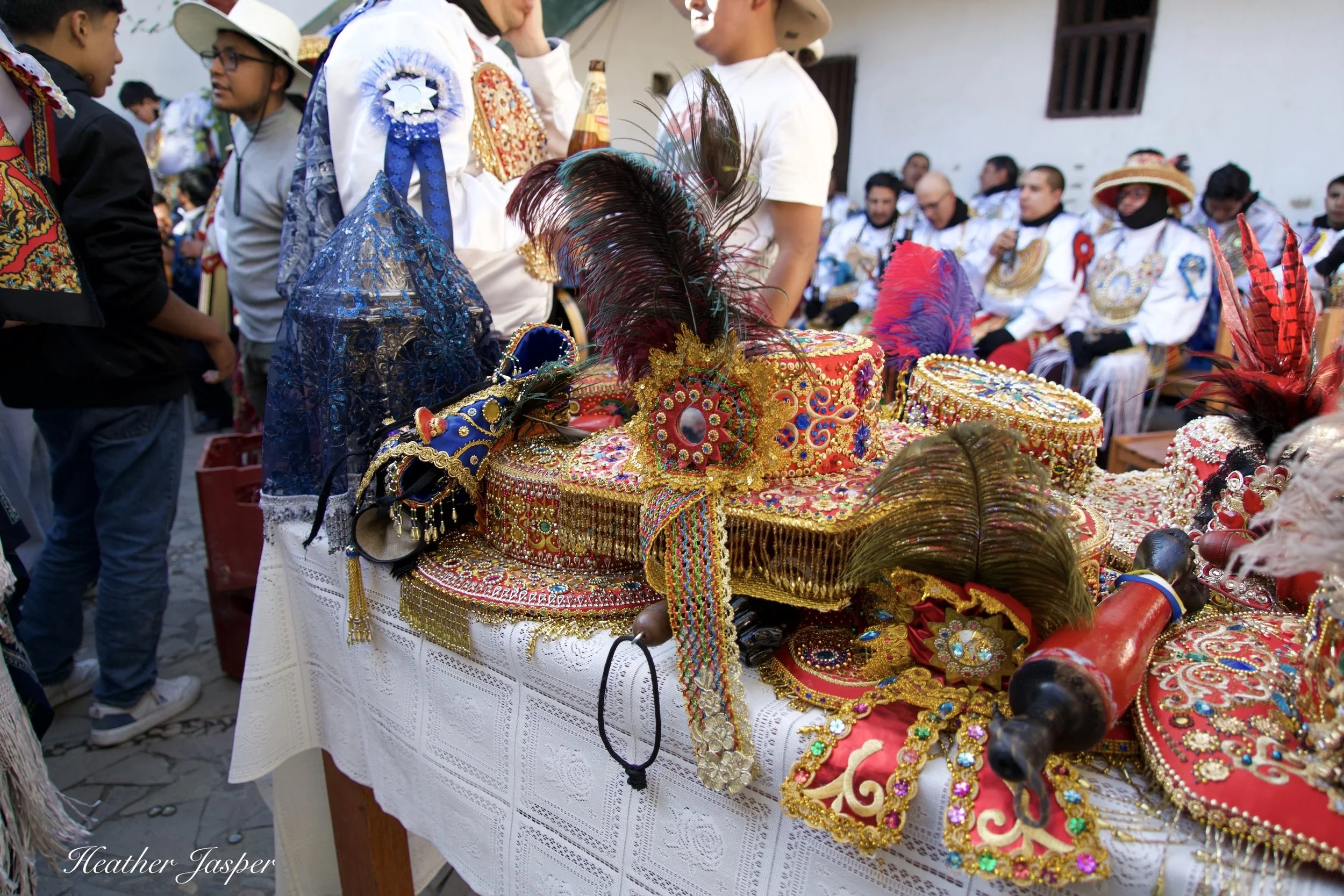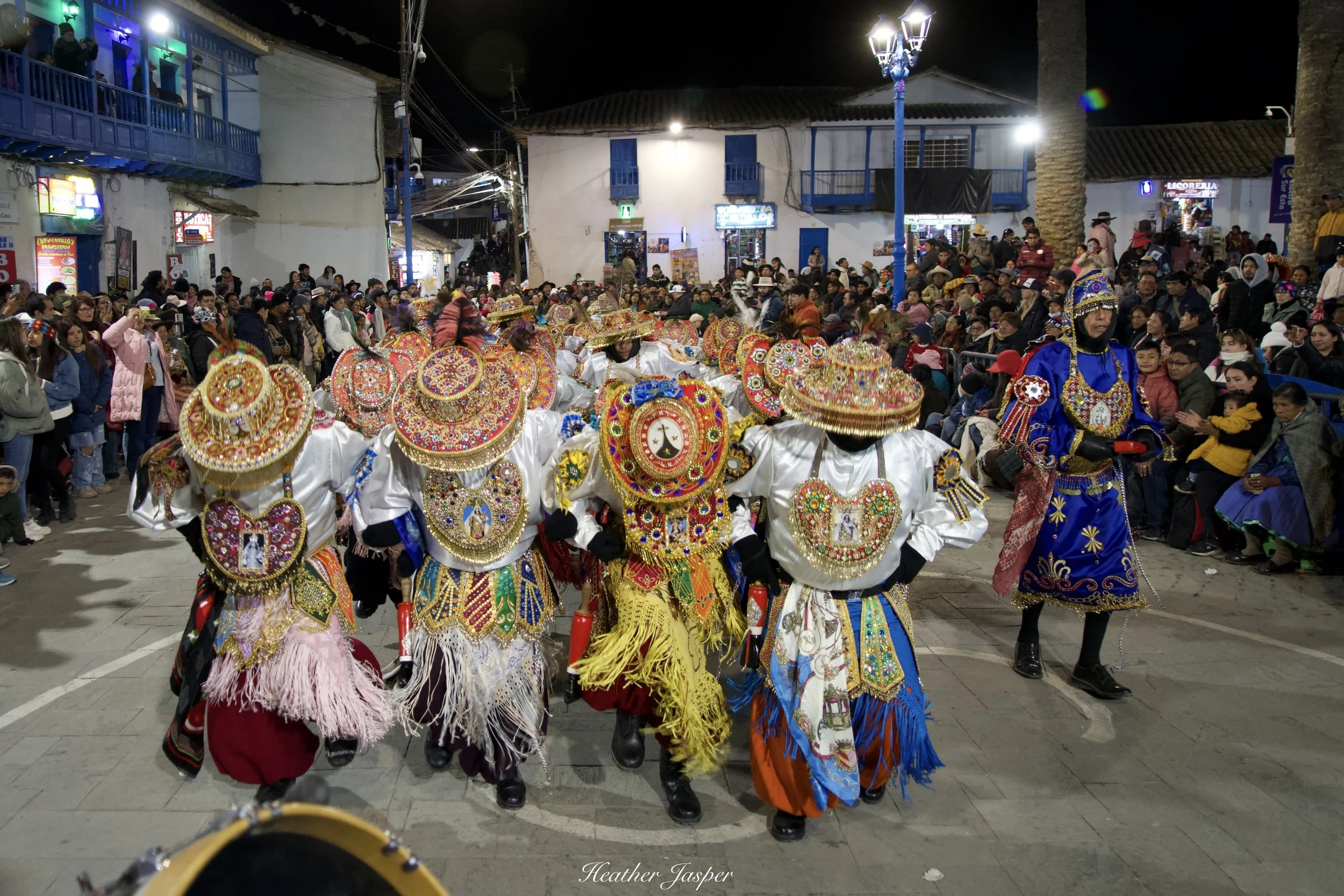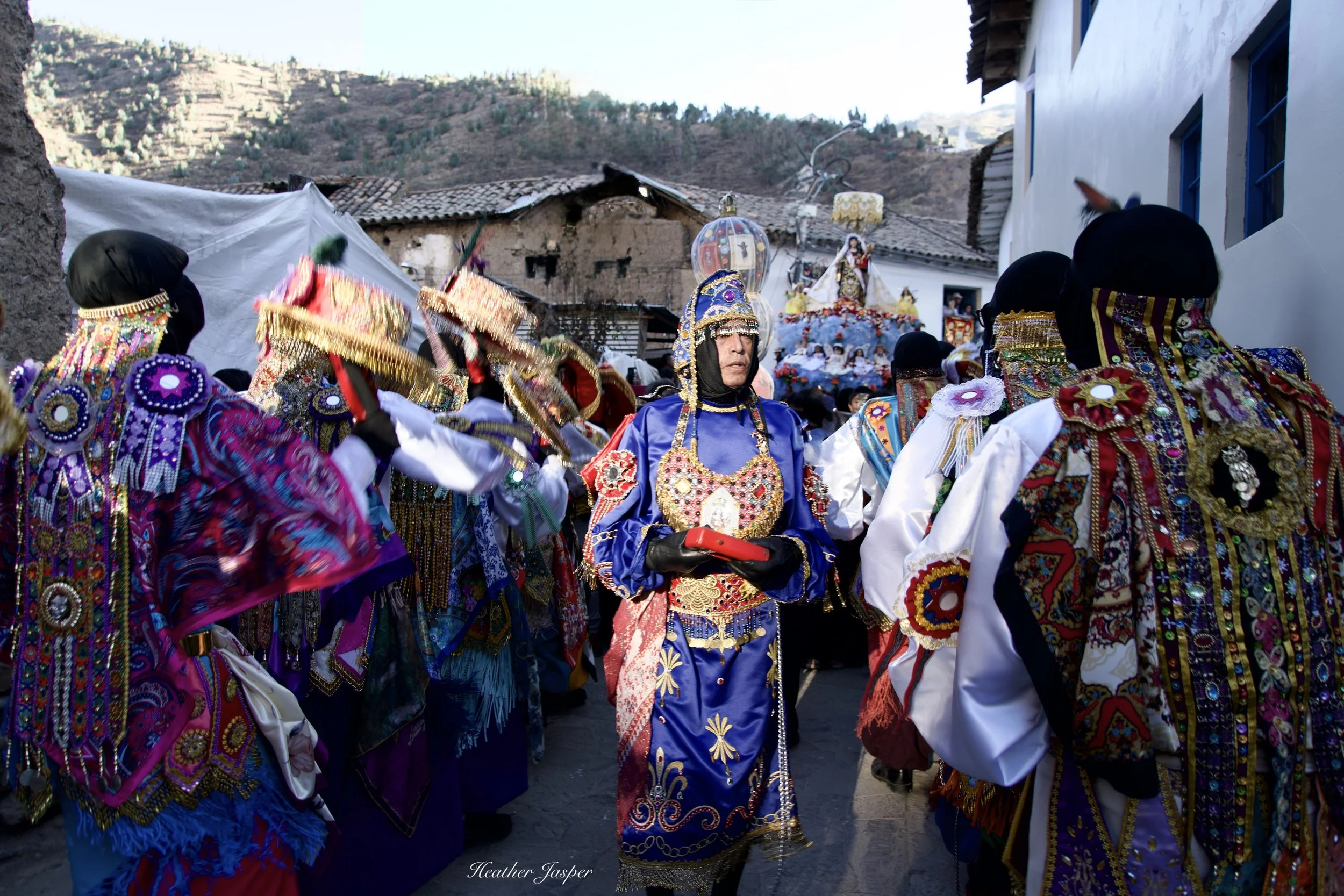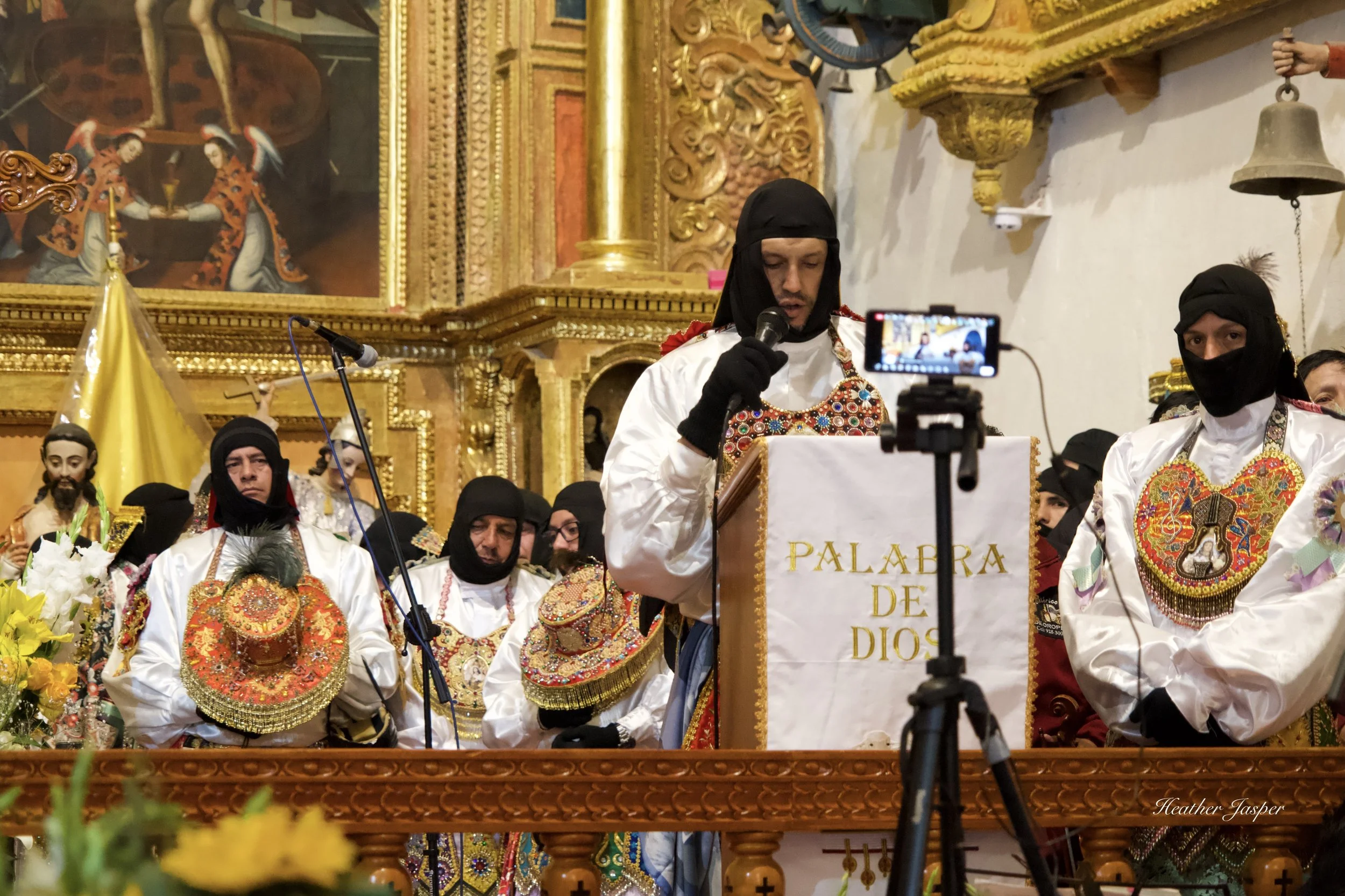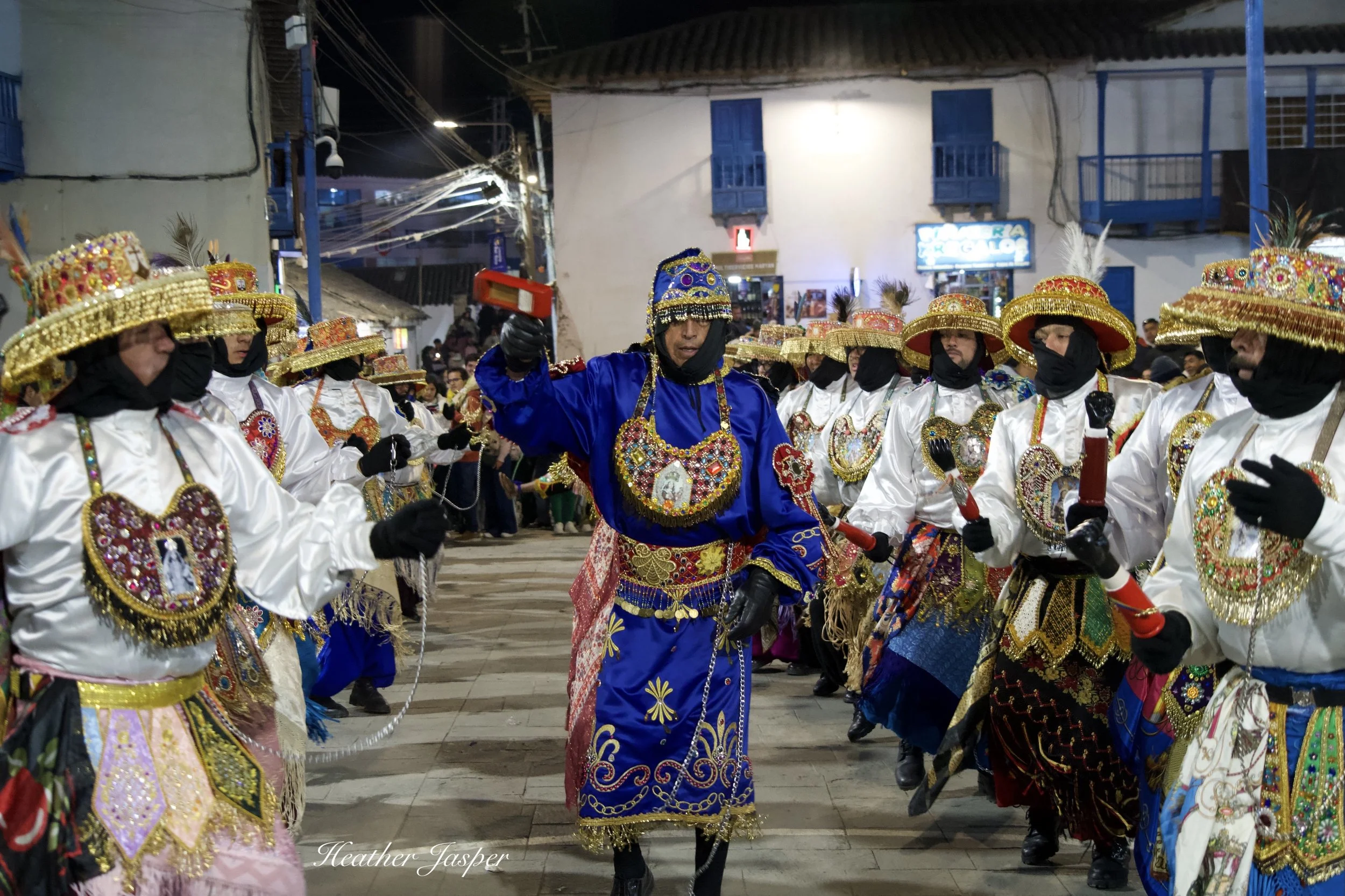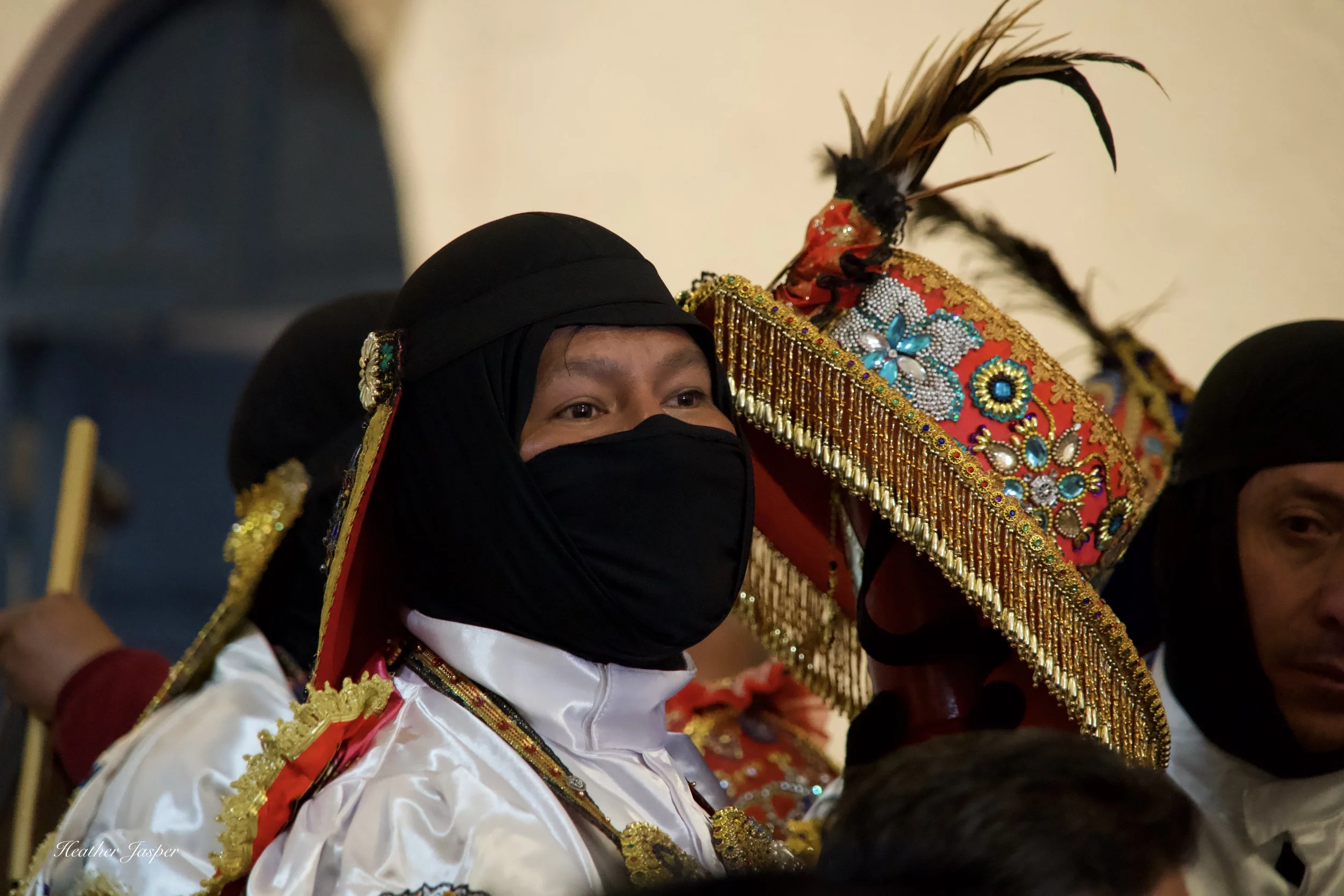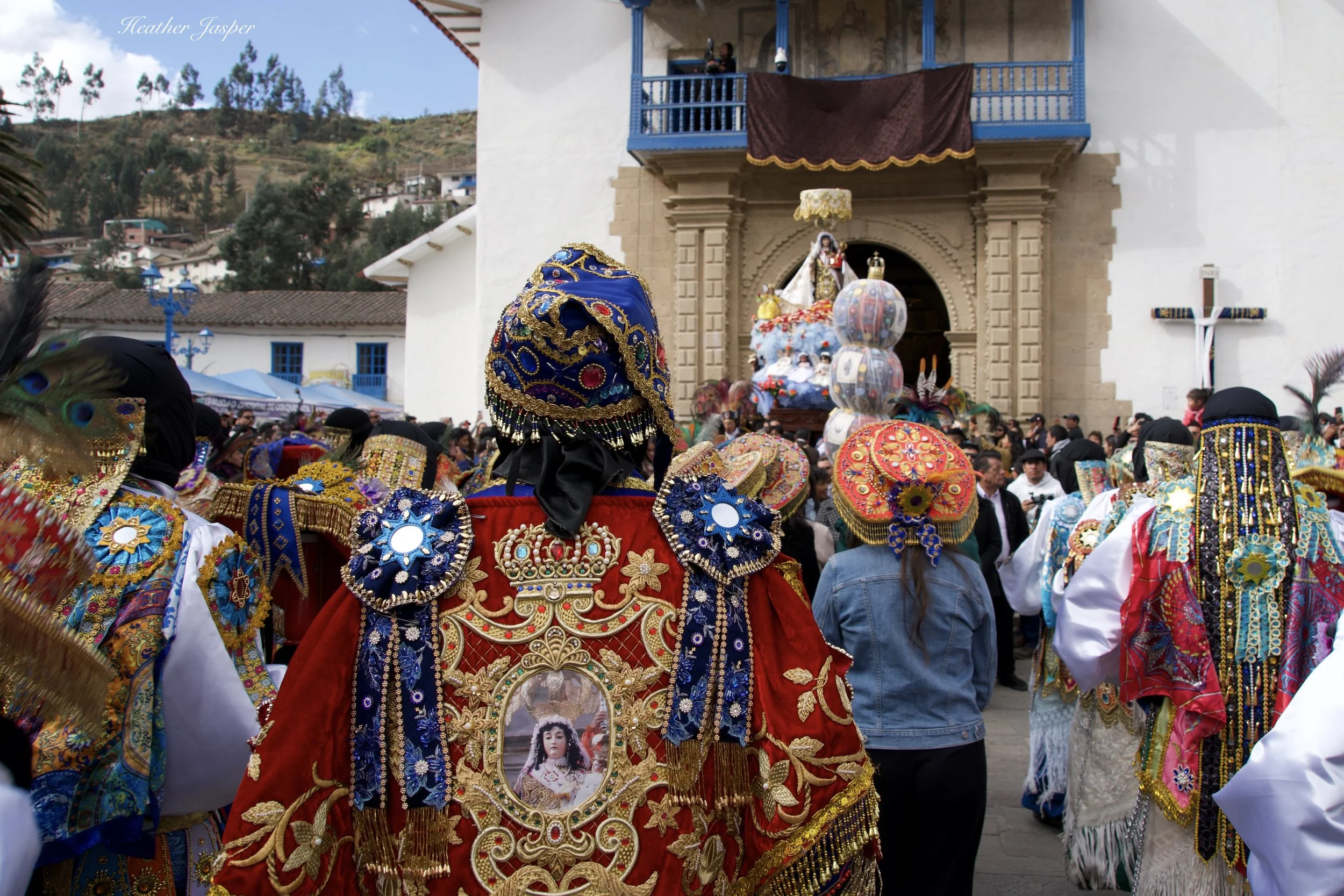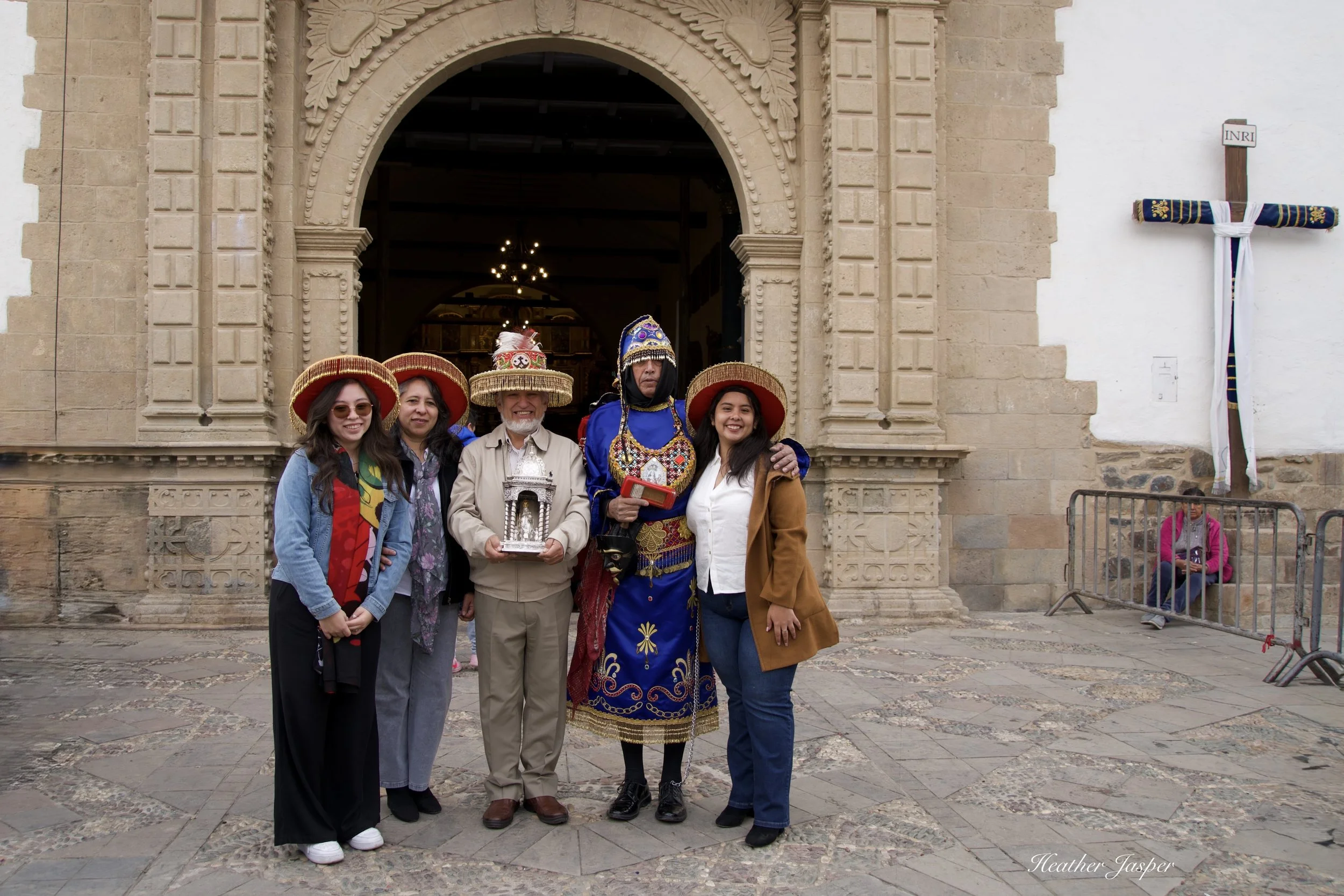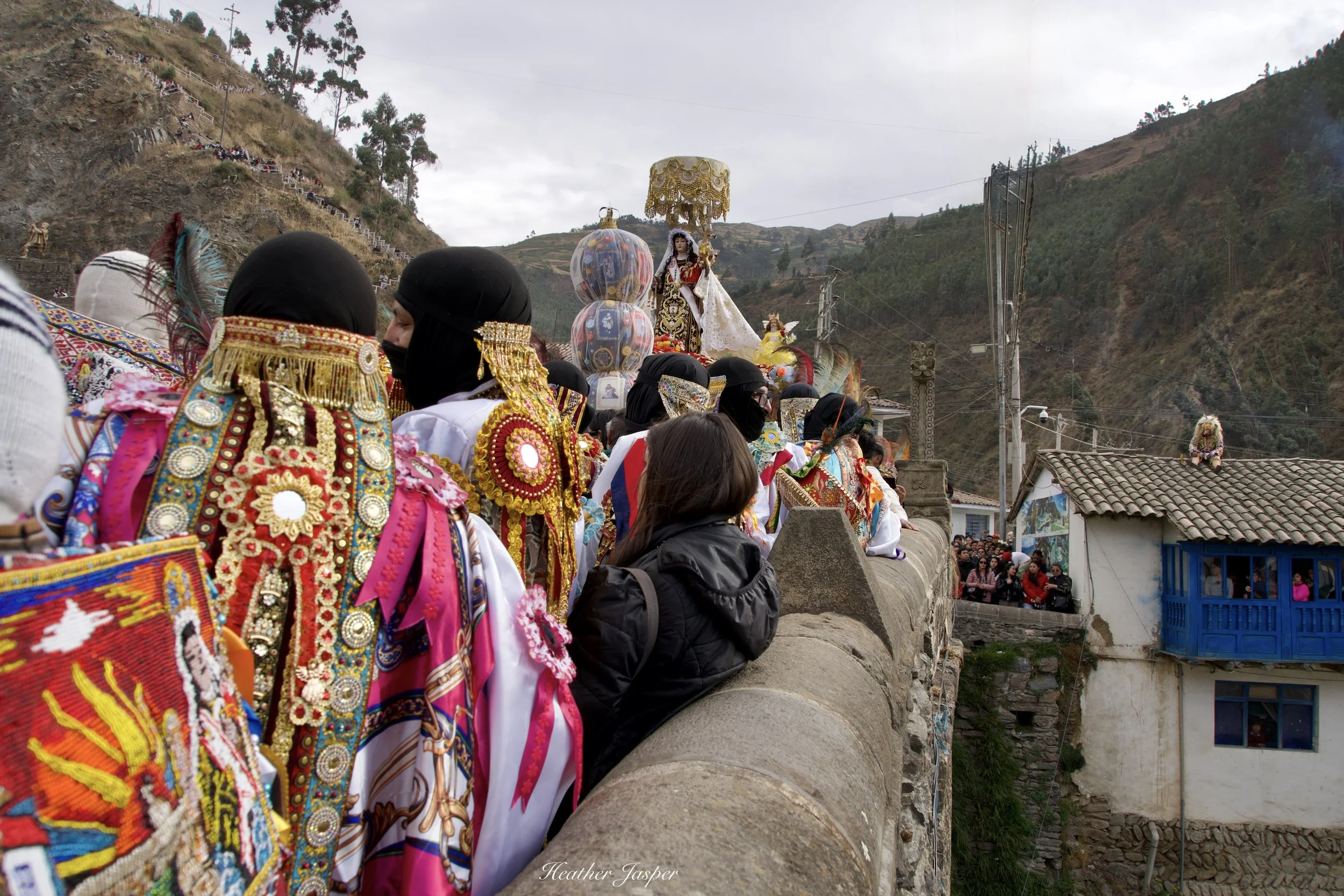Qhapaq Negro
The Qhapaq Negro remove their hats and masks when facing the Virgin of Carmen.
Paucartambo’s Famous Festividad de la Virgen del Carmen
Love and devotion run deep in all nineteen danzas, the dance troupes that come to Paucartambo every July to dance for the Virgin of Carmen. That devotion is shown most dramatically by the Qhapaq Negro, the dancers who represent the slaves of the Virgin of Carmen.
Like the syncretic nature of all Paucartambo’s danzas, the Qhapaq Negro are a multifaceted representation that mixes elements of many cultures and peoples. The most obvious elements are of enslaved African people who were taken to Paucartambo to work in sugar cane fields and gold mines during the colonial period, seen in the Qhapaq Negro masks, black wooden hands and chains. Their Andean heritage comes through loud and clear in the songs they sing to the Virgin in Quechua. Their European roots show in the masks’ blue eyes, their clothes and their devotion to a Virgin brought from Spain to spread Catholicism in the Peruvian rainforest.
The Qhapaq Negro remove their hats in the church, holding them up on their wooden maki.
An Annual Festividad
The Festividad de la Virgen del Carmen takes place every year July 15-18 in Paucartambo, a two-hour drive from Cusco, Peru. You can read more about the celebrations and a danza called Saqra in my blogs from 2023 and 2024. (Note: I use the Spanish word festividad rather than the English word festival because Father Mijail of Paucartambo told me not to call it a festival).
I first met the Qhapaq Negro when I went to their Yayurichikuy in April. This is an important event that all danzas hold annually in Paucartambo, between January and May. They attend mass at the Paucartambo church, then go to their cargo wasi, the hall owned by the danza where they have dance practice and eat all their meals together during the four days of the festividad. The Yayurichikuy is when the dancers commit to dance during the festividad this year, they commit themselves to the Qhapaq Negro and to the Virgin of Carmen.
Fredi Villagarcía Aquise has been the Qhapaq Negro’s Guiador for 40 years.
The Guiador
The Qhapaq Negro leader is called the Guiador (guide) and Fredi Villagarcía Aquise has been the Guiador since 1985. The Yayurichikuy was my opportunity to introduce myself and ask him permission to accompany the Qhapaq Negro during the festividad this year. To really get to know a danza, I want to be with them from the moment they put on their costumes the first day, the 15th through the end of the festividad on the 18th.
Each of the nineteen danzas have different roles during the festividad and each has to be at different places during the four days. The Qhapaq Negro, as the slaves of the Virgin, accompany her anytime she is carried out of the church in procession. They wait for her outside the door and when she appears they take off their masks and hats, hanging the masks from their right arm and perching the hats on their wooden maki which they hold in their right hand.
The wooden maki has a black fist, white cuff and red sleeve with a metal plate on the back of the wrist.
Quechua Vocabulary
The maki is a black wooden forearm and hand, the arm painted red, and the hand painted black. The word maki is Quechua for hand, and Fredi has made each maki for the past forty years, as a present when a new dancer joins the Qhapaq Negro.
The word qhapaq is also Quechua and can be translated as rich or royal. There are three danzas with the word qhapaq in their name: Qhapaq Negro, Qhapaq Qolla and Qhapaq Chuncho. Their richness doesn’t refer to money but to their closeness to the Virgin. All three danzas accompany the Virgin when she leaves the church and they all have special roles that keep them close to her during the festividad.
With their masks off, and their hats perched on their makis, the Qhapaq Negro walk backwards, never turning their back on the Virgin and rarely taking their eyes off her. That part was challenging for me, but I learned to walk backwards, just like I learned to stick with the musicians who were always between the two lines of Qhapaq Negro.
The musicians accompany the dancers everywhere. They start playing at breakfast and go till past midnight.
The Musicians
Like all danzas, the Qhapaq Negro have a live band that follows them everywhere. The musicians have to learn the different songs that the danza sings and they have to pay attention to the Guidador, who tells them when to switch between songs and when to stop playing. The band has two accordions, one drum, three violins and four flutes. If I stayed with them, protected by a line of dancers on each side, I was less likely to get swept away by the crowd or to be evicted by the Maqtas.
The Maqta wear Andean hats and clothes but their masks are grotesque versions of a European face.
Keeping Order
Maqtas keep order throughout the festividad. At any given time during the four days, they know which danza has to be at the church, who should be in the plaza, who should be on the bridge and who should be leaving or returning to their cargo wasi. They have braided llama fur whips and clear the crowd for the dancers, making sure they get places on time and protecting them from their adoring fans. Since I was clearly not a dancer or musician, Maqtas generally assumed that I was in the way and would push me into the crowd if one of the Qhapaq Negro didn’t protect me. At one point, the crowd was so intense, and the Maqtas so sure I didn’t belong, that the Guiador had to link arms with me and pull me back into the middle of the dancers.
Qhapaq Negro Richard has a photo of the Virgin of Carmen, her symbol above and hummingbirds next to her.
The Costume
Besides the masks, hats and makis, the Qhapaq Negro wear a rounded pechera hung around their neck and covering most of their chest. It always has a photo of the Virgin of Carmen and is elaborately beaded. They wear chains that link one foot to their waist and at some points in their dances they hold the chains up in their left hand and the maki in the right. They wear scarves pinned to their shoulders and draped over their back as well as a fringed scarf around their waist, and colorful, baggy pants.
Most of the time, their masks, gloves and costume completely cover every inch of skin. This is because they are playing a role in the festividad, and their character as Qhapaq Negro is what’s important, not the individual behind the mask. Most danzas’ costumes also cover the dancers completely, and the others don’t take off their masks or hats when facing the Virgin.
About the masks
To anybody from the US, the Qhapaq Negro masks evoke some of the worst images of blackface and minstrel shows. Yet, Peruvians don’t have that history and don’t see the masks like that. The culture here is very different.
The Qhapaq Negro swirl around each other, in different formations for each song.
The Choreography
The Qhapaq Negro have the most complicated choreography of any of the danzas I’ve seen. The Guiador has trained them well and they move seamlessly between lines, circles, pinwheels and other formations. He keeps time with a matraca, which tells them when to switch between formations, though they have to know the order, since he doesn’t say anything when he spins the matraca.
Matraca
The Guiador uses this matraca to mark time during the dances and to signal to the Qhapaq Negro when to transition between dance formations.
The women wearing Qhapaq Negro hats are next year’s carguyoc, the sponsors who will fund the festividad.
The Cargo Wasi
In Quechua, a wasi is a house or home and this is where each danza can take off their masks and not be in character. The cargo is the burden, carried every year by the carguyoc, a mix of the Spanish word cargo and the Quechua suffix -yoc, meaning belonging to. Every danza has a carguyoc who funds everything the danza needs during the four days: musicians, cooks, food and lots and lots of beer. The cooks prepare three meals a day, starting on the 14th and ending on the 19th. This year there were 79 Qhapaq Negro and 6 kids dancing with them and you can count an extra four or five family members at each meal for each dancer. For a danza as big as the Qhapaq Negro, the cost can be well over a year’s salary. Other danzas have fewer people, so the carguyoc doesn’t buy the same quantity of food, but the musicians and cooks are expensive no matter how many dancers they’re supporting.
Considering the cost, you would think it would be hard to find carguyoc, but the Qhapaq Negro, and many other danzas, have people lined up for the honor. They currently have families pledged to carry the financial burden up through 2032. Many people need that long to save up the full cost of supporting a danza throughout the festividad.
The Qhapaq Negro hang their hats, masks and makis behind them during meals.
Feeding the Community
At each meal, the cooks make more food than they think they’ll need. This helps in case more people show up than expected but it also is meant to feed the community. The tradition for all danzas, at all cargo wasis,is that anybody who can find a seat at a table will be served along with the dancers. People who can’t get a seat at a table are welcome to stand around the door and will still be fed. There are plenty of people who set up food stalls throughout the town, so the cargo wasi isn’t the only place to eat. The tradition is more for people who can’t afford to buy food but who come to see the Virgin. In Paucartambo, anybody who attends the festividad to honor the Virgin of Carmen deserves a hot meal.
The Qhapaq Negro wait for the Virgin of Carmen on the Carlos III bridge, built in 1775.
Gratitude to the Qhapaq Negro
From the Yayurichikuy through the end of the festividad, all the Qhapaq Negro made me feel very welcome. They let me take photos of everything, answered all my questions and made sure I had a spot at the table to eat with them. They were unendingly gracious, and I am so very thankful for their support.

